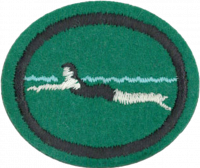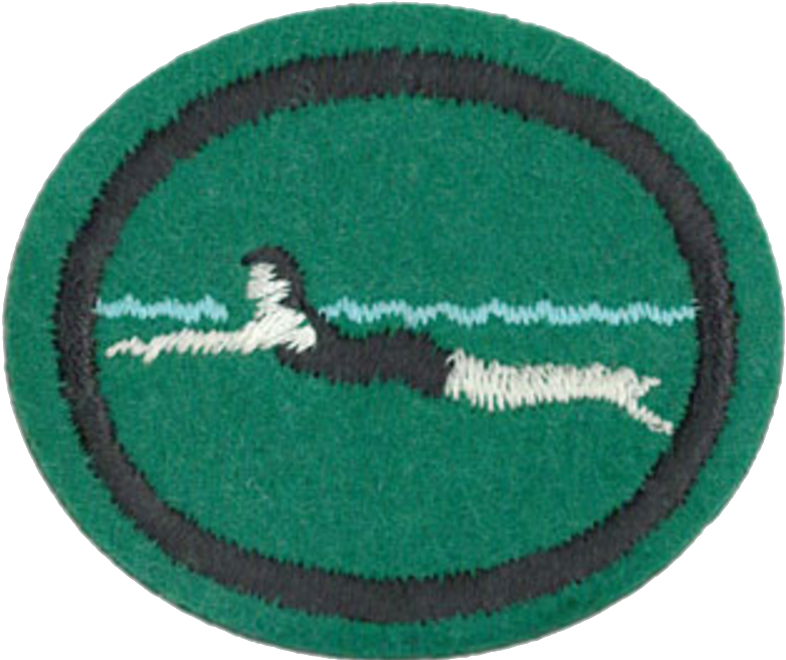AY Honors/Swimming - Beginner/Answer Key
Skill Level
1
Year
1944
Version
27.11.2025
Approval authority
North American Division
While it is not required that you have a professional teach you (or your kids) to swim, it is highly advisable. Check with your local pool (a local college, or YMCA for example) to see what kind of swimming courses are offered. If you are unsure where your nearest American Red Cross (ARC), or YMCA is, then check online at: Red Cross (in the middle near the top there is a place to enter your zip code so that you can locate your locale ARC chapter); or YMCA (there is a box off to the left that will allow you to enter your zip code). If you choose to not have a professional teach you, you will find the requirements below.
1
Start with breath holding at least 10 seconds with eyes open. Sink toys and some coins. Goggles may be used. It might help to exhale the breath rather than filling the lungs. This will help the swimmer stay submerged while the small object is sought.
2
When head is out of the water, inhale with the mouth. When underwater, exhale with mouth and nose. Rhythm shall be just like the natural breathing pattern. Inhale quickly and exhale slowly.
3
With the bobbing motion, move forward through the water by pushing the water backwards. With fingers together and palms flat, do a sweeping motion on the water from the front to the back, recover then repeat motion over again. Slightly jump to maintain bobbing pattern while sculling forward.
4
Stay clear of the sides and make sure that there is no object or swimmer before jumping. Maintain feet first entry and stay safe at all times.
5
Kneeling dive
Extend arms overhead with hands together. Link thumbs to help keep forearms tight along sides of head (covering ears). Bend one knee to the deck, the other knee to the chest keeping foot flat on the deck. Curl toes over the edge of the deck for support. Lean forward aiming fingers towards water, push off and bring legs together while entering the water. Fingers enter water first followed by the rest of the body in a straight prone form. Glide into water without kicking. Keep facing down and arms locked over ears. Do not look up. Do not bend your knees. A strong push from the deck will allow you to glide for about ten to fifteen feet. Practice! Practice! Practice!
Compact Jump
Cover mouth and nose with one hand, cross the other arm to the opposite shoulder and push both arms as close to the body. Stand at the edge of the water and jump with feet together. Maintain compact and upright position until movement stops underwater then swim to safety.
6
Prone means on the front.
Stand in waist to chest deep water, push yourself towards the wall by sculling while transferring feet from floor to wall. Streamline your body by extending arms, elbows straight and hands close together. Kick off from the wall and straighten knees. Hold breath as long as possible. When performed properly, this can push-off for up to three body lengths.
7
Supine means on the back.
Hold the gutter and kick off with both feet extending arms into streamline position. Straighten knees and point toes downward. Exhale when the water covers the mouth and nose. Hold position as long as possible.
8
9
10
It is advisable to practice with the student on the deck before entering the water. The child who is timid about the lesson is more apt to become comfortable with the motions of the elementary backstroke if allowed to practice prior to getting in the water.
Start by standing straight with both arms at your side and feet together (Prone Position). Then bring arms up by gliding hands up your sides to your armpits. Then extend arms straight out to form a "T". Bring the arms straight down again in a sweeping motion (fingers together to form a solid surface to push the water) to end up in beginning prone position.
The leg motions are basically the same. Out of the water, only one leg can be used to practice this movement. Allow knee to open outward as leg bends and foot raises upward toward buttocks. Then in an outward sweeping motion, open the leg to form a "V" and then snapping it back down toward other foot. The foot will work as a paddle to push the water out of the way. The traditional way of this movement instructed that the knees should stay close together, as if glued together. Currently this isn't practiced as strictly.
Once in the pool, it's necessary to place your hand under the small of the child's back for support. A styrofoam swim "noodle" could be incorporated in place of your hand. This will allow hands-free assistance during the lesson. Have the child practice the arm motions separately from the leg motions. Practicing each motion separately will increase confidence on their part and an easier transition to using both the hand and foot motions together as a complete swimming stroke.
Practice the complete stroke for several minutes while keeping your hand or the noodle in place on the lower back until the child is comfortable enough to go solo. Continue working with child until he/she is comfortable enough to practice without assistance with the goal of swimming across the shallow end of the pool by themself.
11
12
13
- NEVER dive in shallow water. You can be Paralyzed.
- If you are unsure about being in deep water, don't go there or wear a flotation device.
- If you see someone get hurt, tell a lifeguard or call 911.
- Never swim alone, always swim with a buddy.
- Wait until no one is within 4 meters
 of the diving board before diving into the water.
of the diving board before diving into the water. - Never swim without a parent or guardian or Lifeguard on duty.
- If your fingers are turning purple or you are shivering, get out of the water and get warmed up.
- Don't try to dive if you have not been taught how to properly.
- If someone is hurt, do not attempt to move them. Get the nearest adult around.
- Be careful, never run, obey the lifeguards and any posted signs.
- Have Fun!
14
Water treading is an aspect of swimming that involves a swimmer staying in a vertical position in the water while keeping his or her head (at least) above the surface of the water. Treading water provides the swimmer an opportunity to keep the head from becoming submerged while not providing sufficient directional thrust to overcome inertia and propel the swimmer in any specific direction.
15
Cover mouth and nose with one hand, cross the other arm to the opposite shoulder (or grab the arm hole of life jacket of the opposite shoulder) and push both arms as close to the body. Stand at the edge of the water and jump with feet together. The life jacket will assist in a quick resurfacing.
16
HELP stands for Heat Escape Lessening Posture. It is a swimming position intended to conserve body heat, and thus, extend survival in cold-water situations. It works best when the swimmer is wearing a PFD. The basic idea is for the swimmer to curl into a compact ball to minimize the amount of the body's surface area that is exposed to cold water. This is done as follows:
- Draw the knees up to the chest.
- Keep the face turned upwards and out of the water.
- Place the upper arms alongside the torso with the forearms folded across the chest. The swimmer may grasp the PFD's arm holes to aid in holding this position.
The HELP position should not be used in swift water conditions, as rushing water presents other hazards which are of greater immediate concern. Specifically, whitewater can dash a person into rocks, or the swimmer's foot can be caught on an obstacle. If the swimmer then falls downstream from the foot entrapment, the current can easily hold the person's head under water. Moving water conveys tremendous force that even the strongest of people cannot overcome.
17
A group of three or more people wearing PFD's (Personal Floatation Device) form a tight circle by either linking arms or holding onto each other in a side-hugging fashion facing the center of the circle. This will allow the water in the center of the circle to warm up due to the collective body heat. Keeping upper body posture straight and bending the knees inward helps the individuals to float and also keeps more of the legs exposed to the warmer water in the center of the circle.
18


